King of Fans P2586R 60 inch Glandon User Manual
King of Fans, Inc. 60 inch Glandon
User manual

®
P2586
93089923_A

Limited Lifetime Warranty
Date Purchased
Store Purchased
UL Model No.
Serial No.
Vendor No.
UPC
111017
P2586
Progress Lighting fan motors are warranted to the original purchaser to be free of electrical and/or mechanical
defects for so long as the original purchaser owns the fan. Pull chain switches, reverse switches, capacitors and
metal nishes are warranted to be free from defects in materials or workmanship for a period of 1 year from
the date of purchase. Warping of wooden or plastic blades is not covered by this warranty nor is corrosion and/
or deterioration of any nishes for fans installed within ten miles of any sea coast. Extended warranties for
ENERGY STAR® qualied products may apply.
Progress Lighting ceiling fans with built-in LED light sources, when properly installed and under normal
conditions of use, are warranted to be free from defects in material and workmanship which cause the light
sources to fail to operate in accordance with the specications for (i) ve (5) years from the date of purchase
on the LED Light modules and electrical components for fans used in single family residences, and (ii) three
(3) years from the date of purchase on the LED Light modules and electrical components for fans used in
multi-family or commercial applications. LED bulbs supplied by Progress Lighting carry no warranty other
than manufacturer’s warranty. Non-LED bulbs carry no warranty.
With proof of purchase, the original purchaser may return the defective fan to the place of purchase during the
rst 30 days for replacement. After 30 days, the original purchaser MUST contact Progress Lighting at (864)
678-1000 for repair or replacement which shall be determined in Progress Lighting’s sole discretion and shall
be purchaser’s sole and exclusive remedy.
Labor and Shipping Excluded. This warranty does not cover any costs or fees associated with the labor
(including, but not limited to, electrician’s fees) required to install, remove, or replace a fan or any fan parts.
This warranty shall not apply to any loss or damage resulting from (i) normal wear and tear or alteration,
misuse, abuse or neglect, or (ii) improper installation, operation, repair or maintenance by original purchaser
or a third party, including without limitation improper voltage supply or power surge, use of improper parts or
accessories, unauthorized repair (made or attempted) or failure to provide maintenance to the fan.
THE FOREGOING WARRANTIES STATE PROGRESS LIGHTING’S ENTIRE WARRANTY OBLIGATION
AND ORIGINAL PURCHASER’S SOLE AND EXCLUSIVE REMEDY RELATED TO SUCH PRODUCTS.
PROGRESS LIGHTING IS NOT RESPONSIBLE FOR DAMAGES (INCLUDING INDIRECT, SPECIAL,
INCIDENTIAL OR CONSEQUENTIAL), DUE TO PRODUCT FAILURE, WHETHER ARISING OUT OF
BREACH OF WARRANTY, BREACH OF CONTRACT, OR OTHERWISE. THIS WARRANTY IS GIVEN
IN LIEU OF ALL OTHER WARRANTIES, WHETHER EXPRESSED OR IMPLIED, INCLUDING THOSE
OF MERCHANTABILITY, FITNESS FOR A PARTICULAR PURPOSE OR NONINFRINGEMENT.
Some states do not allow limitations on how long an implied warranty lasts or the exclusion or limitations
of incidental or consequential damages, so the above limitations and exclusions may not apply to you. This
warranty gives you specic rights and you may have other rights which vary from state to state.
785247 222087

Safety Rules
Unpacking Your Fan
Installing Your Fan
Making the Electrical Connections
Operating Your Fan
Care of Your Fan
Troubleshooting
Specications
Table of Contents
1
2
3
6
10
11
11
12

1. To reduce the risk of electric shock, insure electricity
has been turned off at the circuit breaker or fuse box
before beginning.
2. All wiring must be in accordance with the National
Electrical Code ANSI/NFPA 70-1999 and local electrical codes.
Electrical installation should be performed by a
qualied licensed electrician.
3. CAUTION: To reduce the risk of personal injury, use only
the screws provided with the electrical box.
4. The outlet box and support structure must be securely
mounted and capable of reliably supporting 35 lbs. (15.9
kg). Use only UL Listed outlet boxes marked “Acceptable
for Fan Support of 35 lbs. (15.9 kg) or less.”
5. CAUTION: The fan must be mounted with a minimum of
7 feet clearance from the trailing edge of the blades to the
oor.
6. Do not operate reversing switch while fan blades are in
motion. Fan must be turned off and blades stopped before
reversing blade direction.
7. Avoid placing objects in path of the blades.
8. To avoid personal injury or damage to the fan and other
items, be cautious when working around or
cleaning the fan.
9. Do not use water or detergents when cleaning the fan or fan
blades. A dry dust cloth or lightly dampened cloth will be
suitable for most cleaning.
10. After making electrical connections, spliced conductors
should be turned upward and pushed carefully up into
electrical box. The wires should be spread apart with the
grounded conductor and the equipment-grounding
conductor on one side of the electrical box and ungrounded
conductor on the other side of the electrical box.
11. Electrical diagrams are for reference only. Light kits that
are not packed with the fan must be UL Listed and marked
suitable for use with the model fan you are installing.
Switches must be UL General Use Switches. Refer to the
instructions packaged with the light kits and switches for
proper assembly.
12. All set screws must be checked and retightened where
necessary before installation.
13. WARNING: To reduce the risk of re or electric shock, do
not use this fan with any solid-state speed control device.
14. Use with speed controller UC7067RYE, manufactured by
Rhine Electronic Co., Ltd only.
1. Safety Rules
READ AND SAVE THESE INSTRUCTIONS
TO REDUCE THE RISK OF FIRE, ELECTRIC SHOCK OR PERSONAL
INJURY, MOUNT TO OUTLET BOX MARKED “ACCEPTABLE FOR FAN
SUPPORT OF 35LBS. (15.9 KG) OR LESS”, AND USE SCREWS PRO-
VIDED WITH THE OUTLET BOX.
TO REDUCE THE RISK OF PERSONAL INJURY, DO NOT BEND THE
BLADE BRACKETS (ALSO REFERRED TO AS (“FLANGES”) DURING
ASSEMBLY OR AFTER INSTALLATION. DO NOT INSERT OBJECTS IN
THE PATH OF THE BLADES.
TO REDUCE THE RISK OF SHOCK, THIS FAN MUST BE INSTALLED
WITH AN ISOLATION CONTROL/SWITCH.

a. Blade attachment hardware
(19 screws for attaching blade arms to the
fan motor assembly)
b. Blade attachment hardware
(19 screws for attaching blades to blade
arms)
c. Blade attachment hardware
(37 screws for attaching blade decorative
bars to blades)
d. Electrical hardware and Balancing kit
(3 plastic wire connectors, blade balancing
kit )
7. Blades (6)
8. Blade Arms (6)
9. Light Kit Pan
10. Light Kit Fitter Assembly
11. Shatter-resistant Shade with Trim Ring
12. Transmitter and Receiver
1. Mounting Bracket (inside canopy)
2. 6” Ball/Downrod Assembly (hanger pin
and locking pin pre-attached)
3. Canopy with Canopy Ring (attached)
4. Decorative Motor Collar Cover
5. Fan Motor Assembly
6. Blade Decorative Bar (6)
2. Unpacking Your Fan
Unpack your fan and check the contents. You should have the following items:
5
1
2
3
47
6
8
9
11
12
10
d
ab
c

3. Installing Your Fan
Tools Required
Phillips screw driver or straight slotted screw
driver, adjustable wrench, step ladder, and
wire cutters.
Mounting Options
If there isn’t an existing electrical box, then
read the following instructions. Disconnect
the power by removing fuses or turning off
circuit breakers.
Secure the electrical box directly to the building
structure. Use appropriate fasteners and
building materials. The electrical box and
its support must be able to fully support the
moving weight of the fan (at least 35 lbs.).
Do not use plastic electrical boxes.
Figures 1, 2, and 3 are examples of different
ways to mount the electrical box.
Note: You may need a longer downrod to
maintain proper blade clearance when installing
on a steep, sloped ceiling. The maximum
angle allowable is 20˚. If the canopy touches
downrod, remove the decorative canopy
bottom cover and turn the canopy 180˚ before
attaching the canopy to the mounting plate.
To hang your fan where there is an existing
xture but no ceiling joist, you may need an
installation hanger bar as shown in Figure 4.
TO REDUCE THE RISK OF FIRE, ELECTRIC
SHOCK OR PERSONAL INJURY, MOUNT
TO OUTLET BOX MARKED “ACCEPTABLE
FOR FAN SUPPORT OF 35LBS. (15.9 KG) OR
LESS”, AND USE SCREWS PROVIDED WITH
THE OUTLET BOX. ELECTRICAL BOXES
COMMONLY USED FOR THE SUPPORT OF
LIGHTING FIXTURES MAY NOT BE ACCEPT-
ABLE FOR FAN SUPPORT AND MAY NEED TO
BE REPLACED. CONSULT A QUALIFIED ELEC-
TRICIAN IF IN DOUBT.
Figure 1
Figure 2
Figure 4
Figure 3
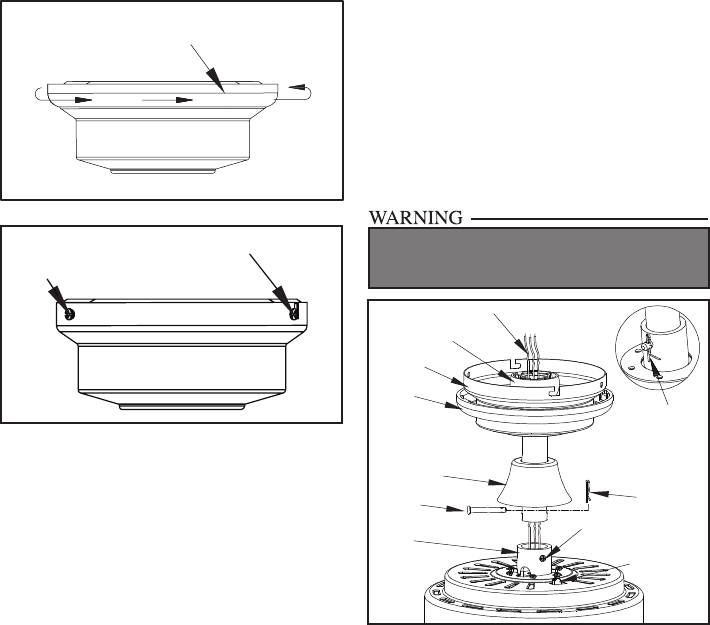
4.
Hanging the Fan
REMEMBER to turn off the power. Follow
the steps below to hang your fan properly.
NOTE: This fan is recommended for
standard ceiling mount using the downrod
provided with this fan. When using standard
ceiling installation with the 6 inch downrod
provided, the distance from the ceiling
to the bottom of the fan blades will be
approximately 14 inches.
Standard Ceiling Mounting
1. Remove the canopy ring from the canopy
by turning the ring counter-clockwise
until it unlocks. (Figure 5)
2. Remove the mounting bracket from the
canopy by loosening the four screws on
the top of the canopy. Remove the two
non-slotted screws and loosen the slotted
screws. This will enable you to remove
the mounting bracket. (Figure 6)
3. Remove the hanger pin and locking pin
from downrod assembly.
4. Route the wires exiting the top of the fan
motor through the decorative motor collar
cover then the canopy ring. Make sure the
slot openings are on top. Route the wires
through the canopy and then through the
ball/downrod assembly. (Figure 7)
Remove
Loosen but Do Not Remove
Turn Canopy Ring to Remove
Figure 5
Figure 6
5. Loosen, but do not remove, the set screws
on the collar on the top of the motor
housing.
6. Align the holes at the bottom of the
downrod with the holes in the collar on top
of the motor housing. (Figure 7)
Carefully insert the hanger pin through the
holes in the collar and downrod. Be careful
not to jam the hanger pin against the wiring
inside the downrod. Insert the locking pin
through the hole near the end of the bolt
until it snaps into its locked position, as
noted in the circle inset of Figure 7.
7. Re-tighten the set screws on the collar on
top of the motor housing.
8. Make sure the grommet is properly installed
in the collar cover, then slide the collar cover
on the downrod until it rests on the motor
housing. Be sure that the canopy and the
collar cover are both oriented correctly.
9. Proceed to “Installing the Fan” section.
FAILURE TO PROPERLY INSTALL SET SCREWS
AS NOTED IN STEP 7 COULD RESULT IN FAN
LOOSENING AND POSSIBLY FALLING.
Figure 7
Motor wires
Ball/Downrod
assembly
Canopy
Canopy
ring
Motor collar
cover
Hanger
pin
Motor
collar
Tighten screws
Locking
pin
Reverse
switch
Pin in
locked
position

Standard mounting
5.
Installing Fan to
the Electrical Box
WHEN MOUNTING THE FAN ON A SLOPED
CEILING, THE STANDARD BALL/DOWNROD
MOUNTING METHOD MUST BE USED. THE
MOUNTING BRACKET MUST BE MOUNTED
SO THAT THE SLOT OPENINGS ARE ON THE
LOWER SIDE BY SLIDING THE MOUNTING
BRACKET FROM THE TOP DOWN.
1. Pass the 120-volt supply wires through the
center hole in the ceiling mounting bracket
as shown in Figure 8.
2. Install the ceiling mounting bracket on the
electrical box by using the mounting screws
provided with the electrical box. Note that
the at side of the mounting bracket is
toward the electrical box. (Figure 8)
3. Tighten the two screws on the electrical box
securely.
4. Carefully lift the fan assembly up to the
ceiling mounting bracket. Make sure the tab
on the mounting bracket is properly seated
in the groove in the hanger ball. (Figure 9)
Figure 8
WHEN USING THE STANDARD BALL/DOWNROD
MOUNTING, THE TAB IN THE RING AT THE
BOTTOM OF THE MOUNTING BRACKET MUST
REST IN THE GROOVE OF THE HANGER BALL.
FAILURE TO PROPERLY SEAT THE TAB IN THE
GROOVE COULD CAUSE DAMAGE TO WIRING. Figure 9

EACH WIRE NUT (WIRE CONNECTOR) SUPPLIED
WITH THIS FAN IS DESIGNED TO ACCEPT UP TO
ONE 12 GAUGE HOUSE WIRE AND TWO WIRES
FROM THIS FAN. IF YOU HAVE LARGER THAN
12 GAUGE HOUSE WIRING OR MORE THAN
ONE HOUSE WIRE TO CONNECT TO THE FAN
WIRING, CONSULT AN ELECTRICIAN FOR THE
PROPER SIZE WIRE NUTS TO USE.
USE THE PLASTIC WIRE CONNECTORS
SUPPLIED WITH YOUR FAN. SECURE THE
CONNECTORS WITH ELECTRICAL TAPE AND
ENSURE THERE ARE NO LOOSE STRANDS OR
CONNECTIONS.
BLUE
BLACK
WHITE
GREEN
BLUE
BLACK WHITE
WHITE
SUPPLY CIRCUIT
BLACK
WHITE
Grounding
Conductor
Green
Grounding
Lead
Remote
Receiver
Figure 10
Making the Electrical
Connections
REMEMBER to disconnect the power. If
you feel you do not have enough electrical
wiring knowledge or experience, have your fan
installed by a licensed electrician.
Follow the steps below to connect the fan to
your household wiring. Use the wire
connecting nuts supplied with your fan and
supplied with remote control. Secure the
connectors with electrical tape. Make sure
there are no loose strands or
connections. (Figure 10)
1. Connect the ground conductor of the 120v
supply (this may be a bare wire or a wire
with green colored insulation) to the green
ground lead(s) of the fan (Figure 10).
2. Connect the fan motor white wire to the
receiver white wire using a wire nut (Figure
10).
3. Connect the fan motor black wire to the
receiver black wire using a wire nut (Figure
10).
4. Connect the fan motor blue wire to the
receiver blue wire using a wire nut (Figure
10).
6.
5. Connect the receiver black wire to the
supply black (hot) wire using a wire nut
(Figure 10).
6. Connect the receiver white wire to the
supply white (neutral) wire using a wire nut
(Figure 10).
7. After connecting the wires, spread them
apart so that the green and white wires are
one side of the electrical box and the black
wire is on the other side.
8. Turn the wire connecting nuts upward and
carefully push the wiring into the electrical
box.
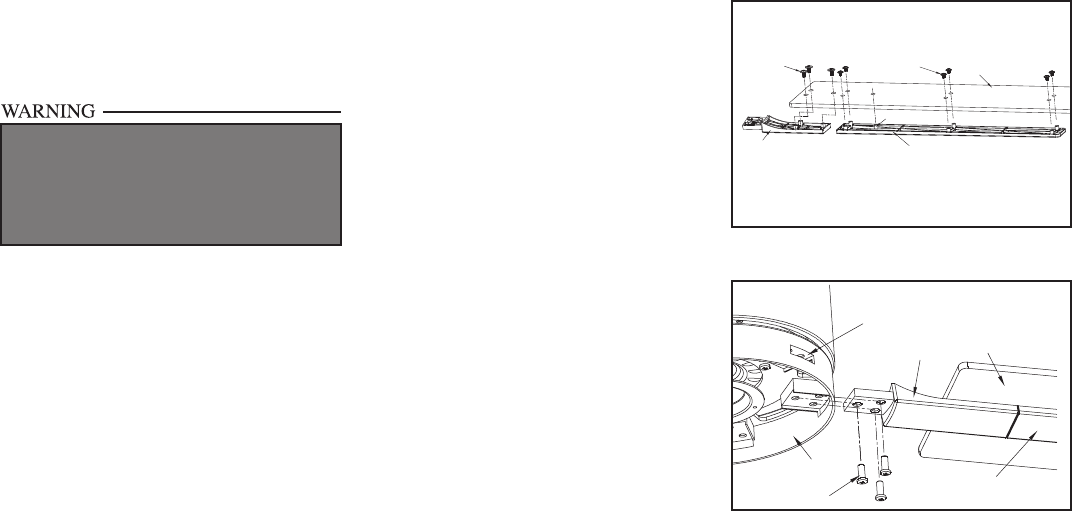
Attaching the Fan
Blades
1. Attach a blade arm to a blade by aligning
three screw holes in the blade arm with the
screw holes in the blade and secure with
screws provided; Attach a blade decorative
bar to the blade by aligning six screw
holes and one alignment post in the blade
decorative bar with the holes in the blade
and secure with screws provided; Repeat
for the remaining blades. (Figure 11)
2. Insert a blade assembly to the slot cut-off
in the center ywheel, align the three screw
holes in the blade assembly with the screw
holes in the ywheel and secure with the
screws provided. Repeat for the remaining
blade assemblies. (Figure 12)
Figure 11
Finishing the Fan
Installation
STANDARD CEILING MOUNTING
1. Align the locking slots of the ceiling
canopy with the two screws in the
mounting plate. Push up to engage the
slots and turn clockwise to lock in place.
Immediately tighten the two mounting
screws rmly.
2. Install the remaining two mounting screws
into the holes in the canopy and tighten
rmly.
3. Install the decorative canopy ring by
aligning the ring’s slots with the screws in
the canopy. Rotate the ring clockwise to
lock in place.
4. You may now proceed to attaching the
fan blades.
WHEN USING THE STANDARD BALL/DOWNROD
MOUNTING, THE TAB IN THE RING AT THE
BOTTOM OF THE MOUNTING PLATE MUST
REST IN THE GROOVE OF THE HANGER BALL.
FAILURE TO PROPERLY SEAT THE TAB IN THE
GROOVE COULD CAUSE DAMAGE TO WIRING.
7.
Blade
Screws Screws
Blade Arm Blade
Decorative
Bar
Alignment Post
Figure 12
Blade
Blade Arm
Blade Decorative Bar
Screws
Flywheel
Slot Cut-off for
Blade Insert

Figure 13
Blade Balancing
All blades are grouped by weight. Because
natural woods vary in density, the fan may
wobble even though the blades are weight
matched.
The following procedure should correct most
fan wobble. Check after each step.
1. Check that all blade screws are secure.
2. Most fan wobble problems are caused
when blade levels are unequal. Check this
level by selecting a point on the ceiling
above the tip of one of the blades. Measure
from a point on the center of each blade
to the point on the ceiling. Measure this
distance as shown in Figure 13. Rotate
the fan until the next blade is positioned
for measurement. Repeat for each blade.
Measurements deviation should be within
1/8”. Run the fan for 10 minutes.
3. Make sure that canopy is tightened securely
to ceiling mounting bracket and that the
ceiling mounting bracket is tightened
securely to the electrical box.
4. Interchanging two adjacent blades can
redistribute the weight and possibly result
in the smoother operation.
5. Use the enclosed Blade Balancing Kit if the
blade wobble is still noticeable.
Touching
Ceiling
8.
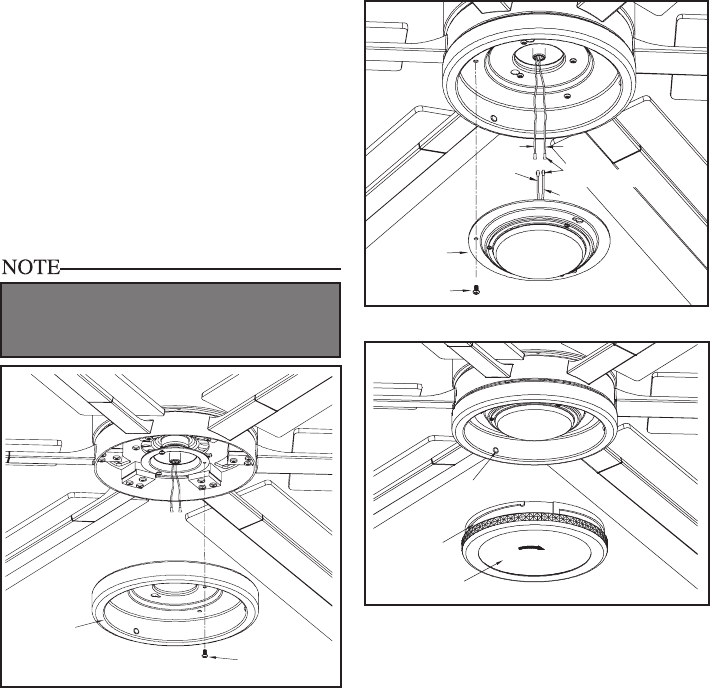
Installing the Light Kit
Pan/Light Kit Fitter
Assembly/ Shatter-
Resistant Shade
CAUTION - To reduce the risk of electrical
shock, disconnect the electrical supply circuit
to the fan before installing the light kit.
1. Loosen but do not remove two of three
mounting screws from the fan motor
assembly; Remove one mounting screw.
(Figure 14)
2. Push the light kit pan up to the fan motor
assembly so that the two loosened screw
heads t into the keyhole slots. Turn the
light kit pan clockwise, tightened the
screws. Re-install the screw that was
removed in step 1 and tighten rmly.
(Figure 14)
3. Remove one screw from the light kit pan
and loosen, but do not remove the other
two screws. Connect the wires from the
light kit tter assembly to the wires from
the fan motor assembly by connecting the
molded adaptor plugs together. Carefully
tuck all wires and splices into the switch
cap. (Figure 15)
4. Push the light kit tter assembly up so
that the two loosened screw heads t into
the keyhole slots. Turn the light kit tter
assembly clockwise, tighten the screws. Re-
install the screw that was removed in step 3
and tighten rmly. (Figure 15)
5. Place the shatter-resistant shade into the
light kit pan, aligning the three at areas on
the top of the shatter-resistant shade with
the three raised dimples in the light kit pan.
Turn the shatter-resistant shade clockwise
until it stops. (Figure 16)
Light Kit
Pan
Mounting
Screw (3)
Black
White
Mounting
Screw (3)
Light Kit Fitter
Assembly
Blue
White
Molded
Adaptor Plugs
Figure 14
Figure 15
PERIODICALLY CHECK THE SHATTER-
RESISTANT SHADE IS SEATED FULLY
CLOCKWISE IN THE LIGHT KIT PAN
ASSEMBLY.
9.
Figure 16
Raised
Dimples
Flat Area
Shatter-
Resistant
Shade
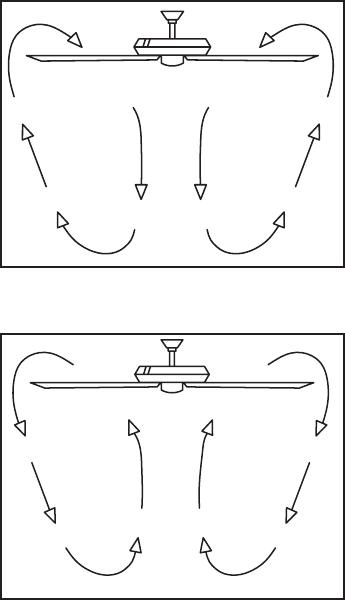
10. Operating Your Fan
Speed settings for warm or cool weather depend
on factors such as room size, ceiling height,
number of fans, and so on.
The fan shipped from the factory with the
reversing switch positioned to circulate air
downward. If airow is desired in the opposite
direction, turn your fan off and wait for the
blades to stop turning, then slide the reversing
switch (located at the top of the motor housing,
refer to gure 7 on page 4) to opposite position,
and turn fan on again. The fan blades will turn
in the opposite direction and reverse airow. Figure 17
Figure 18
Warm weather - (Forward) A downward air
ow creates a cooling effect as shown in Figure
17. This allows you to set your air conditioner
on a higher setting without affecting your
comfort.
Cool weather - (Reverse) An upward air ow
moves warm air off the ceiling are as shown in
Figure 18. This allows you to set your heating
unit on a lower setting without affecting your
comfort.

11. Care of Your Fan and Troubleshooting
Care of Your Fan
Here are some suggestions to help you
maintain your fan.
1. Because of the fan’s natural movement,
some connections may become loose.
Check the support connections, brackets,
and blade attachments twice a year. Make
sure they are secure. (It is not necessary to
remove fan from ceiling.)
2. Clean your fan periodically to help maintain
its new appearance over the years. Do not
use water when cleaning, this could damage
the motor, or the wood or possibly cause
an electrical shock. Use only a soft brush
or lint-free cloth to avoid scratching the
nish. The plating is sealed with a lacquer
to minimize discoloration or tarnishing.
Warning - Make sure the power is off
before cleaning your fan.
3. You can apply a light coat of furniture polish
to the wood for additional protection and
enhanced beauty. Cover small scratches
with a light application of shoe polish.
4. There is no need to oil your fan.
The motor has permanently lubricated
sealed ball bearings. MAKE SURE THE POWER IS OFF AT THE ELECTRICAL PANEL BOX
BEFORE YOU ATTEMPT TO MAKE ANY REPAIRS. REFER TO THE SECTION,
“MAKING ELECTRICAL CONNECTIONS.”
Fan will not start
Fan sounds noisy
1. Check main and branch circuit fuses or breakers
2. Check line wire connections to the fan and switch wire connections in
the switch housing. CAUTION: Make sure main power is off.
3. Check batteries in the transmitter. Does the red LED light come on?
Are you standing close enough to the fan? (Normal range is 10-20
feet.) Are the dip switch settings the same on the transmitter (hand unit)
and receiver? REMEMBER TO TURN OFF POWER SUPPLY
BEFORE CHECKING THE DIP SWITCH SETTINGS IN
RECEIVER.
1. Make sure all motor housing screws are snug.
2. Make sure the screws that attach the fan blade bracket to the motor hub
are tight.
3. Make sure wire nut connections are not rattling against each other or
the interior wall of the switch housing.
CAUTION: Make sure power is off.
4. Allow a 24-hour “breaking in” period. Most noises associated with a
new fan disappear during this time.
5. If using the Ceiling Fan light kit, make sure the screws securing the
glassware are tight. Check that the light bulb is also secure.
6. Make sure the canopy is a short distance from the ceiling.
It should not touch the ceiling.
7. Make sure your electrical box is secure and rubber isolator pads were
used between the mounting bracket and electrical box.
Troubleshooting
Problem Solution

12. Specications
FAN
SIZE SPEED VOLTS
FAN POWER
CONSUMPTION
(WITHOUT LIGHTS)
WATTS
AIRFLOW
CFM
AIRFLOW
EFFICIENCY
(HIGHER IS BETTER)
CFM/WATT
NET
WEIGHT
GROSS
WEIGHT
CUBE
FEET
60”
Low
120
12 1678 140 28.88
Lbs
31.97
Lbs 2.0
Med 29 2927 101
High 86 5388 63
©2017 Progress Lighting, Inc.
701 Millennium Blvd.,
Greenville, SC 29607
All Rights Reserved
This equipment has been tested and found to comply with the limits for a Class B digital device, pursuant to Part 15 of the FCC Rules. These limits
are designed to provide reasonable protection against harmful interference in a residential installation. This equipment generates, uses and can radiate
radio frequency energy and, if not installed and used in accordance with the instructions, may cause harmful interference to radio communications.
However, there is no guarantee that interference will not occur in a particular installation. If this equipment does cause harmful interference to radio
or television reception, which can be determined by turning the equipment off and on, the user is encouraged to try to correct the interference by one
or more of the following measures:
--Reorient or relocate the receiving antenna.
--Increase the separation between the equipment and receiver.
--Connect the equipment into an outlet on a circuit different from that to which the receiver is connected.
--Consult the dealer or an experienced radio/TV technician for help.
CAUTION:
Any changes or modications not expressly approved by the grantee of this device could void the user’s authority to operate the equipment.
This device complies with Part 15 of the FCC Rules. Operation is subject to the following two conditions: (1) This device may not cause harmful
interference, and (2) this device must accept any interference received, including interference that may cause undesired operation.
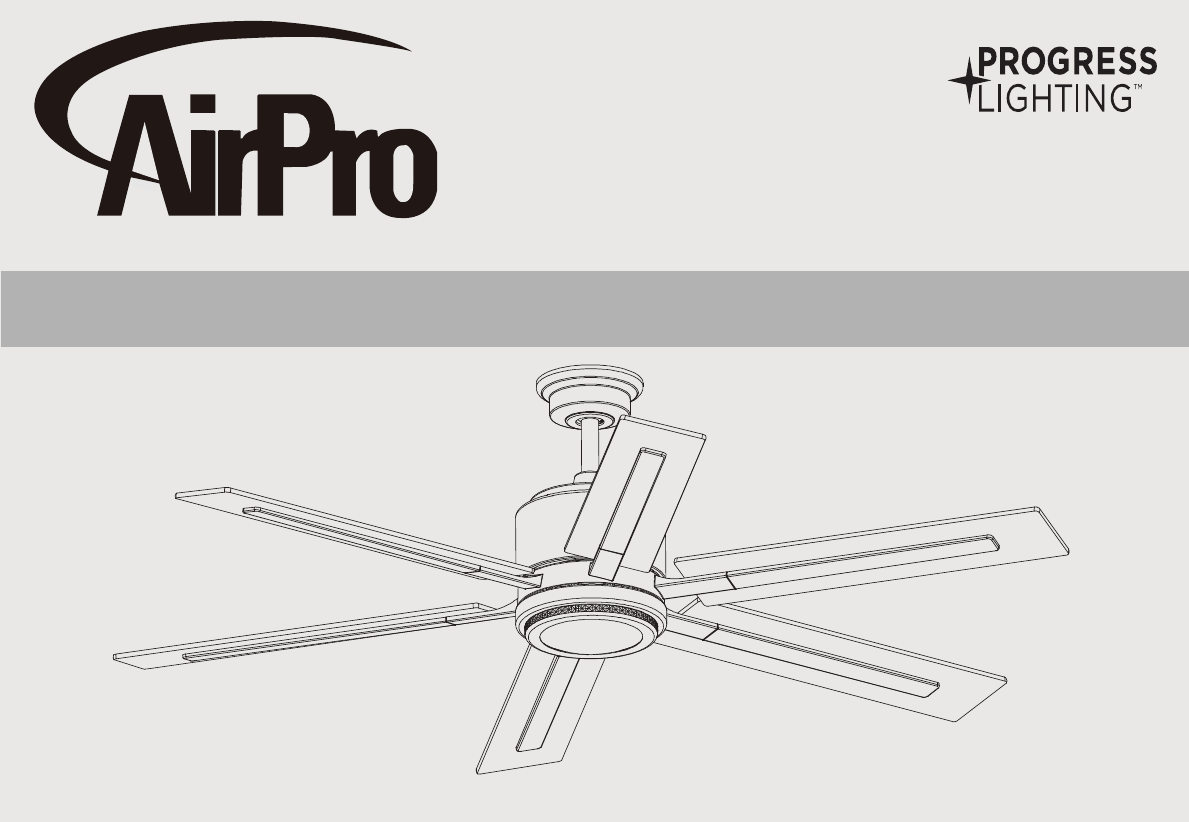
®
Manual de instalación del ventilador de techo
P2586
93089923_A

Garantía limitada de por vida
Fecha de compra
Tienda de compra
Modelo UL #
Número de serie
Proveedor #
UPC
111017
P2586
Los motores de ventilador Progress Lighting se garantizan al comprador original como libres de defectos eléctricos y/o mecánicos
por el tiempo en que estén en posesión de dicho comprador. Los interruptores activados por cadena, los interruptores de reversa,
los capacitores y los acabados de metal se garantizan como libres de defectos materiales o de fabricación por un periodo de 1
año desde la fecha de compra. Las deformaciones de las aspas de madera o plástico no están cubiertas por esta garantía así como
no lo están tampoco la corrosión y/o deterioro del acabado de ventiladores instalados a menos de diez millas de la costa del mar.
Pudieran aplicarse garantías extendidas para productos ENERGY STAR® que caliquen.
Los ventiladores de techo Progress Lighting con fuentes de luz LED incorporadas, si han sido bien instalados y bajo condiciones
normales de uso, se garantizan como libres de defectos materiales y de fabricación que puedan causar un fallo en el funcionamiento
según las especicaciones de dichas fuentes de luz durante un periodo de (i) cinco (5) años a partir de la fecha de compra para los
módulos de luz LED y componentes eléctricos de ventiladores usados en residencias unifamiliares y durante (ii) tres (3) años para
ventiladores usados residencias multifamiliares o en instalaciones comerciales. Las bombillas LED suministradas por Progress
Lighting sólo poseen la garantía del fabricante. Las bombillas que no sean LED no tienen garantía.
Con prueba de la compra, el comprador original puede devolver el ventilador defectuoso, para su reposición, al lugar donde lo
compró y dentro de los 30 días siguientes a la compra. Pasados 30 días, el comprador original TIENE que contactar a Progress
Lighting llamando al (864) 678-1000 para reparación o reposición, según determine Progress Lighting a su entera discreción, y
este será el único y exclusivo remedio del comprador.
Se excluyen cargos por mano de obra y envío. Esta garantía no cubre ningún costo ni cargo asociado a la mano de obra
(incluyendo, pero sin limitarse a, los cargos del electricista) que se requiera para instalar, retirar o reponer un ventilador o
cualquiera de sus partes.
Esta garantía no cubre ninguna pérdida o daño resultante de (i) desgaste normal o alteración, mal uso, abuso o negligencia, o (ii)
instalación, operación, reparación o mantenimiento incorrectos por el comprador original o un tercero, incluso sin limitación del
suministro de tensión o sobrecarga de alimentación, uso de piezas o accesorios inadecuados, reparación no autorizada (realizada
o intentada) o falta de mantenimiento al ventilador.
LAS GARANTÍAS ANTERIORES ESTABLECEN LA OBLIGACIÓN DE GARANTÍA TOTAL DE PROGRESS
LIGHTING Y EL ÚNICO Y EXCLUSIVO REMEDIO DEL COMPRADOR ORIGINAL RELACIONADO CON DICHOS
PRODUCTOS. PROGRESS LIGHTING NO ES RESPONSABLE POR NINGÚN DAÑO (SEAN INDIRECTOS,
ESPECIALES, INCIDENTALES O CONSECUENTES) DEBIDO A FALLAS DEL PRODUCTO, YA SEAN DERIVADAS DE
INCUMPLIMIENTO DE LA GARANTÍA O DEL CONTRATO, O DE CUALQUIER OTRA CAUSA. ESTA GARANTÍA SE
OTORGA EN LUGAR DE TODAS LAS DEMÁS, YA SEAN EXPRESAS O IMPLÍCITAS, INCLUIDAS LAS GARANTÍAS
DE COMERCIABILIDAD, IDONEIDAD PARA UN PROPÓSITO EN PARTICULAR O NO INFRACCIÓN.
Algunos estados no permiten limitaciones en la duración de una garantía implícita ni exclusión o limitaciones de daños
incidentales o consecuentes, así que las exclusiones o limitaciones anteriores pudieran no aplicarse a su caso. Esta garantía
otorga derechos especícos y es posible que usted tenga otros derechos que varían según el estado.
785247 222087

Normas de seguridad
Cómo desempacar el ventilador
Cómo instalar el ventilador
Cómo hacer las conexiones eléctricas
Cómo usar el ventilador
Cuidado del ventilador
Solución de problemas
Especicaciones
Tabla de contenido
1
2
3
6
10
11
11
12

1. Para disminuir el riesgo de descarga eléctrica, antes de comenzar
la instalación asegúrate de que la electricidad ha sido cortada en el
cortacircuitos o en la caja de fusibles.
2. Todo el cableado tiene que cumplir con el Código Nacional de
Electricidad ANSI/NFPA 70-1999 y con los códigos locales de
electricidad. La instalación eléctrica debe hacerse por un electricista
calicado con licencia.
3. PRECAUCIÓN: Para reducir el riesgo de lesiones físicas, usa sólo
los tornillos suministrados con la caja de distribución.
4. La caja eléctrica y estructura de soporte tienen que montarse de
forma segura para poder sostener con conanza 35 lb (15.9 kg). Usa
solo cajas eléctricas aprobadas por UL y marcadas como “apropiadas
para sostener ventiladores de 35 lb (15.9 kg) o menos”.
5. PRECAUCIÓN: El ventilador tiene que montarse con al menos 7 pies
(2.13 m) de separación entre el borde trasero de las aspas y el piso.
6. No operar el interruptor de reversa mientras las aspas del ventilador
estén en movimiento. El ventilador tiene que estar apagado y las
aspas detenidas antes de invertir el sentido del movimiento.
7. Evita colocar objetos en la trayectoria de las aspas.
8. Para evitar lesiones personales o daños al ventilador y otros artículos,
ten cuidado al limpiarlo o al trabajar cerca de él.
9. No usar agua ni detergentes para limpiar el ventilador o las aspas.
Para limpiar, casi siempre será adecuado un paño seco o ligeramente
humedecido con qué quitar el polvo.
10. Después de hacer las conexiones eléctricas, los conductores
empalmados deben voltearse hacia arriba y empujarse con cuidado
dentro de la caja eléctrica. Los cables deben estar separados, con
el cable y el conductor a tierra del equipo hacia uno de los lados de
la caja eléctrica, y el conductor sin conexión a tierra hacia el lado
opuesto.
11. Los diagramas eléctricos son sólo para referencia. Los kits de luces
no empaquetados con el ventilador tienen que estar aprobados por UL
y marcados como apropiados para usar con el modelo de ventilador
que estás instalando. Los interruptores tienen que estar clasicados de
uso general por UL. Para ensamblar bien, consulta las instrucciones
adjuntas a los kits de luces e interruptores.
12. Antes de la instalación, todos los tornillos de jación tienen que
comprobarse y reajustarse donde sea necesario.
13. ADVERTENCIA: Para reducir el riesgo de incendio o descarga eléctrica,
no use este ventilador con ningún dispositivo de control de velocidad de
estado sólido.
14. Este ventilador sólo debe usar la pieza núm. UC7067RYE de control de
velocidad fabricada por Rhine Electric Co., Ltd..
1. Normas de seguridad
LEE Y GUARDA ESTAS INSTRUCCIONES
PARA REDUCIR EL RIESGO DE INCENDIO, DESCARGA ELÉCTRICA O LESIONES,
INSTALA SÓLO EN UNA CAJA ELÉCTRICA CLASIFICADA COMO “APROPIADA
PARA SOSTENER VENTILADORES DE 35 LB (15.9 KG) O MENOS”, Y USA LOS
TORNILLOS SUMINISTRADOS CON LA CAJA ELÉCTRICA.
PARA REDUCIR EL RIESGO DE LESIONES, NO DOBLES LOS BRAZOS DE LAS
ASPAS (TAMBIÉN LLAMADOS “REBORDES”) DURANTE NI DESPUÉS DE LA
INSTALACIÓN. NO COLOCAR OBJETOS EN LA TRAYECTORIA DE LAS ASPAS.
PARA REDUCIR EL RIESGO DE DESCARGA ELÉCTRICA, ESTE VENTILADOR
TIENE QUE INSTALARSE CON UN CONTROL/INTERRUPTOR DE AISLAMIENTO.
ADVERTENCIA
ADVERTENCIA
ADVERTENCIA

a. Herrajes para montaje de las aspas
(19 tornillos para conectar los brazos de las
aspas al conjunto motor-ventilador)
b. Herrajes para montaje de las aspas
(19 tornillos para conectar las aspas a sus
brazos)
c. Herrajes para montaje de las aspas
(37 tornillos para conectar las barras
decorativas de las aspas a estas últimas)
d. Accesorios eléctricos y kit de compensación
(3 conectores plásticos de cable, kit de
compensación de aspas )
7. Aspas (6)
8. Brazos de aspas (6)
9. Carcasa del kit de luces
10. Conjunto del soporte del kit de luces
11. Pantalla resistente a impactos con aro
decorativo
12. Transmisor y receptor
1. Soporte de montaje (dentro de la cubierta)
2. Conjunto de tubo bajante/bola de 6"
(15.2 cm) (con pasador de soporte y de cierre
prejados)
3. Cubierta con aro de cubierta (acoplado)
4. Cubierta decorativa del collarín del motor
5. Conjunto motor-ventilador
6. Barra decorativa de aspa (6)
2. Cómo desempacar el ventilador
Desempaca tu ventilador y revisa el contenido. Debes tener los siguientes artículos:
5
1
2
3
47
6
8
9
11
12
10
d
ab
c
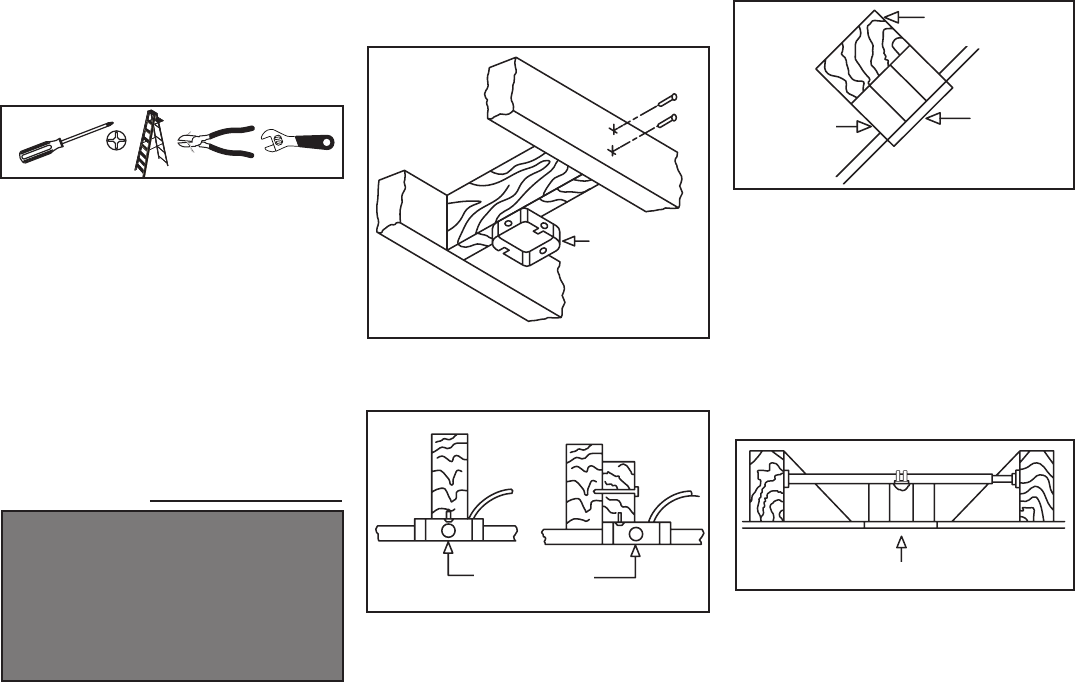
3. Cómo instalar el ventilador
Herramientas necesarias
Destornillador Phillips o de punta plana, llave
ajustable, escalera de tijera y cortacables.
Opciones de montaje
Si no hay una caja eléctrica presente, lee
las siguientes instrucciones. Desconecta la
energía retirando los fusibles o apagando
los cortacircuitos.
Asegura la caja eléctrica directamente a la
estructura de la edicación. Usa sujetadores y
materiales de construcción apropiados. La caja
eléctrica y su soporte tienen que poder sostener
todo el peso en movimiento del ventilador (al
menos 35 lb = 15.9 kg).
No uses cajas eléctricas de plástico.
Las guras 1, 2 y 3 ejemplican diferentes
maneras de montar la caja eléctrica.
Nota: Tal vez necesites un tubo bajante
más largo para mantener la altura mínima
adecuada de las aspas al instalar el ventilador
en un techo muy inclinado. El ángulo máximo
permitido es 20º. Si la cubierta toca el
tubo bajante, retira la cubierta inferior
decorativa y gira la cubierta 180º antes de
jarla a la placa de montaje.
Para colgar el ventilador donde haya una
lámpara, pero ninguna viga de techo, tal
vez necesites una barra colgante de instalación
como se muestra en la Figura 4.
PARA REDUCIR EL RIESGO DE INCENDIO, DESCARGA
ELÉCTRICA O LESIONES, INSTALA SÓLO EN UNA
CAJA ELÉCTRICA CLASIFICADA COMO “APROPIADA
PARA SOSTENER VENTILADORES DE 35 LB (15.9 KG)
O MENOS”, Y USA LOS TORNILLOS SUMINISTRADOS
CON LA CAJA ELÉCTRICA. LAS CAJAS ELÉCTRICAS
COMÚNMENTE UTILIZADAS COMO SOPORTE PARA
INSTALACIONES FIJAS DE ILUMINACIÓN PUEDEN NO
SERVIR COMO SOPORTE DEL VENTILADOR Y TAL VEZ
DEBAN REEMPLAZARSE. CONSULTA A UN ELECTRICISTA
CALIFICADO SI TIENES DUDAS.
Figura 1
Figura 2
Figura 4
Figura 3
ADVERTENCIA
Caja eléctrica
Provee un
soporte fuerte
Placa
de montaje
en techo
Caja eléctrica
empotrada
Caja eléctrica Caja eléctrica
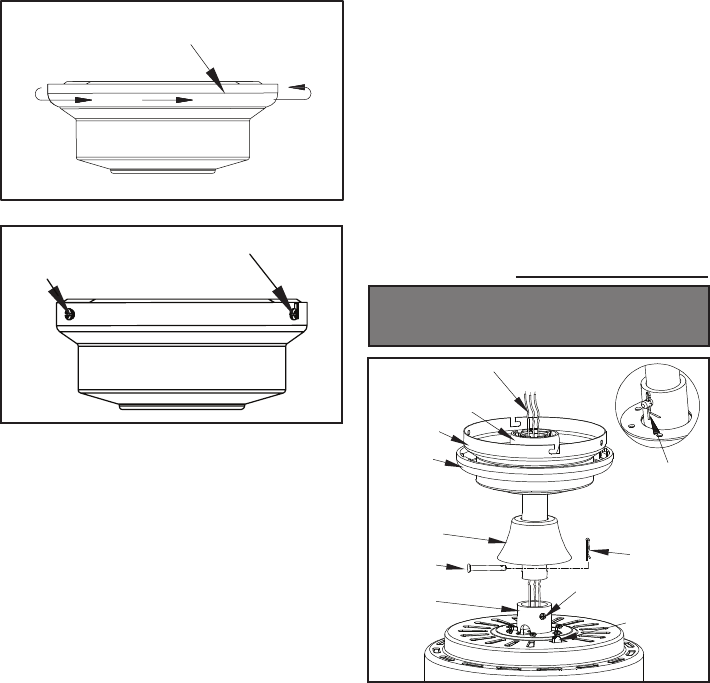
4.
Cómo colgar el ventilador
RECUERDA cortar el suministro de electricidad.
Sigue los pasos más abajo para colgar
correctamente tu ventilador.
NOTA: Se recomienda instalar este ventilador
en techo interior estándar usando el tubo bajante
incluido. Cuando uses una instalación de techo
estándar con el tubo bajante de 6 plg (15.2 cm)
suministrado, la distancia desde el techo a la parte
inferior de las aspas será de unas 14 plg (35.6 cm).
Montaje estándar en techo
1. Retira el aro de la cubierta, girándolo en
sentido contrario a las agujas del reloj hasta que
se libere. (Figura 5)
2. Retira el soporte de montaje de la cubierta
aojando los cuatro tornillos en la parte
superior de ella. Quita los dos tornillos sin
ranura y aoja los tornillos ranurados. Esto te
permitirá retirar el soporte de montaje. (Figura 6)
3. Retira los pasadores de soporte y de cierre en el
conjunto del tubo bajante.
4. Inserta los cables que salen por la parte superior
del motor del ventilador, a través de la cubierta
decorativa del collarín del motor y enseguida
por el aro de la cubierta. Asegúrate de que las
ranuras queden en la parte superior. Inserta
los cables a través de la cubierta y enseguida
a través del conjunto del tubo bajante y bola.
(Figura 7)
Remove
Loosen but Do Not Remove
Turn Canopy Ring to Remove
Figura 5
Figura 6
5. Aoja, sin quitarlos, los tornillos de jación en el
collarín de la parte superior de la carcasa de motor.
6. Alinea los oricios en la parte inferior del tubo
bajante con aquellos del collarín en la parte
superior de la carcasa de motor. (Figura 7).
Inserta con cuidado el pasador de soporte a
través de los oricios del collarín y del tubo
bajante. Ten cuidado de no apretar contra el
cableado dentro del tubo bajante. Inserta el
pasador de cierre en el oricio cercano al extremo
del perno hasta que encaje en su posición, como
se muestra en el círculo de la Figura 7.
7. Vuelve a apretar los tornillos del collarín en la
parte superior de la carcasa del motor.
8. Asegúrate de que el ojal quede instalado
correctamente en la cubierta del collarín y
desliza enseguida la cubierta del collarín por
el tubo bajante hasta quedar sobre la carcasa
del motor. Asegúrate de que tanto la cubierta
como la cubierta del collarín estén orientadas
correctamente.
9. Pasa a la sección "Cómo instalar el ventilador".
SI NO INSTALAS BIEN LOS TORNILLOS DE FIJACIÓN,
COMO SE INDICA EN EL PASO 7, PUEDEN AFLOJARSE
Y POSIBLEMENTE SE CAERÁ EL VENTILADOR.
Figura 7
Motor wires
Ball/Downrod
assembly
Canopy
Canopy
ring
Motor collar
cover
Hanger
pin
Motor
collar
Tighten screws
Locking
pin
Reverse
switch
Pin in
locked
position
ADVERTENCIA
Cables del motor
Cubierta
Conjunto del tubo
bajante/bola
Aro de
la cubierta
Cubierta
del collarín
del motor
Posición de
cierre del
pasador
Pasador de
soporte
Pasador de
cierre
Ajusta todos los
tornillos
Interruptor
de reversa
Collarín del
motor
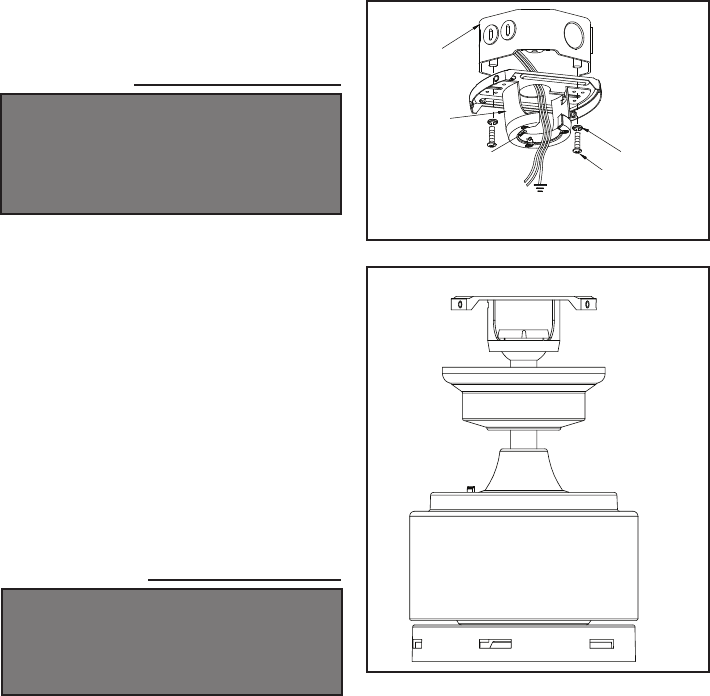
Standard mounting
5.
Cómo instalar el ventilador
en la caja eléctrica
AL INSTALAR EL VENTILADOR EN UN TECHO
INCLINADO, TIENES QUE HACERLO POR EL
MÉTODO DE MONTAJE ESTÁNDAR CON TUBO
BAJANTE Y BOLA. EL SOPORTE DE MONTAJE
TIENE QUE INSTALARSE DE MANERA TAL QUE
LAS ABERTURAS DE RANURA QUEDEN SOBRE EL
LADO INFERIOR, DESLIZANDO EL SOPORTE DE
MONTAJE DESDE LA PARTE SUPERIOR HACIA ABAJO.
1. Pasa los cables de alimentación de 120 V a
través del oricio central en el soporte de
montaje de techo como muestra la Figura 8.
2. Instala el soporte de montaje de techo sobre la
caja eléctrica, usando los tornillos de montaje
incluidos. Nota que el lado plano del soporte de
montaje está hacia la caja eléctrica. (Figura 8)
3. Aprieta bien los dos tornillos en la caja
eléctrica.
4. Con cuidado alza el conjunto del ventilador
hasta el soporte de montaje en el techo.
Asegúrate de que la pestaña en el soporte de
montaje esté bien asentada dentro de la ranura
de la bola de soporte. (Figura 9)
Figura 8
EN EL MONTAJE ESTÁNDAR DE TUBO BAJANTE Y
BOLA, LA PESTAÑA EN EL ARO DE LA PARTE INFERIOR
DEL SOPORTE DE MONTAJE TIENE QUE ENCAJAR EN
LA RANURA DE LA BOLA DE SOPORTE. NO ENCAJAR
BIEN LA LENGÜETA EN LA RANURA PUDIERA DAÑAR
EL CABLEADO. Figura 9
ADVERTENCIA
PRECAUCIÓN
Caja
eléctrica
aprobada
por UL
Tornillos
de montaje
(Suministrados con
la caja eléctrica)
Soporte de
montaje en
techo
Gancho Arandelas
Cables de 120 V
Montaje estándar
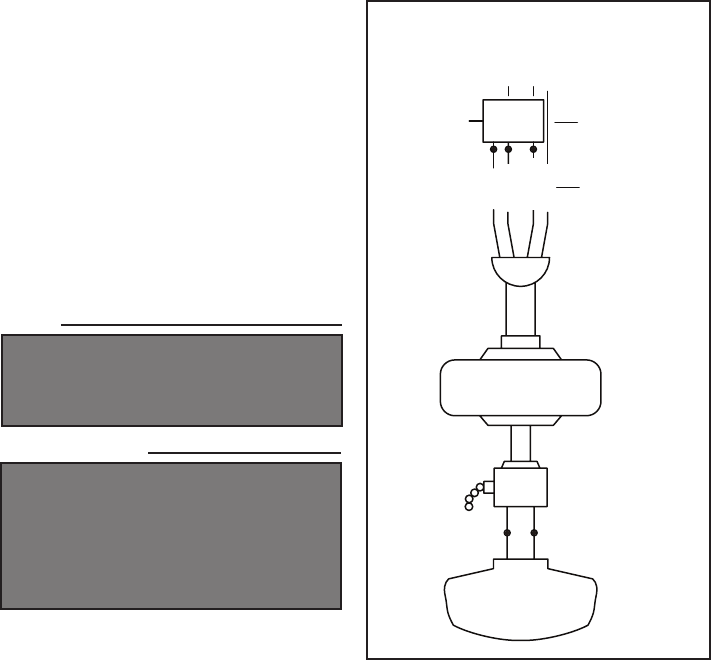
CADA TUERCA DEL CABLE (CONECTOR DE CABLE)
INCLUIDA CON ESTE VENTILADOR ESTÁ DISEÑADA
PARA ACEPTAR UN CABLE DOMÉSTICO DE CALIBRE
12 COMO MÁXIMO Y DOS CABLES DEL VENTILADOR.
SI TIENES UN CABLEADO DOMÉSTICO DE CALIBRE
SUPERIOR A 12, O MÁS DE UN CABLE DOMÉSTICO
PARA CONECTAR EL CABLEADO DEL VENTILADOR,
CONSULTA A UN ELECTRICISTA PARA EL TAMAÑO
ADECUADO DE TUERCAS DE CABLE.
USA LOS CONECTORES DE CABLES PLÁSTICOS
INCLUIDOS CON TU VENTILADOR. SUJETA LOS
CONECTORES CON CINTA DE ELECTRICISTA Y
ASEGÚRATE DE QUE NO HAYA CONEXIONES NI
CABLES SUELTOS.
BLUE
BLACK
WHITE
GREEN
BLUE
BLACK WHITE
WHITE
SUPPLY CIRCUIT
BLACK
WHITE
Grounding
Conductor
Green
Grounding
Lead
Remote
Receiver
Figura 10
Cómo hacer las
conexiones eléctricas
RECUERDA cortar el suministro de
electricidad. Si crees que no tienes suciente
experiencia o conocimientos en cableado
eléctrico, contrata a un electricista con licencia
para que instale el ventilador.
Sigue estos pasos para conectar tu ventilador
al circuito de tu hogar. Usa las tuercas de
conexión de cable incluidas con el ventilador
y el control remoto. Asegura los conectores
con cinta aislante. Asegúrate de que no haya
conexiones ni cables sueltos. (Figura 10)
1. Conecta el conductor a tierra del cable de
120 V (puede ser un cable desnudo o un
cable con aislante verde) al (los) cable(s)
terminal(es) a tierra verde(s) del ventilador
(Figura 10).
2. Conecta el cable blanco del motor del
ventilador al cable blanco del receptor
usando una tuerca de cable (Figura 10).
3. Conecta el cable negro del motor del
ventilador al cable negro del receptor
usando una tuerca de cable (Figura 10).
4. Conecta el cable azul del motor del
ventilador al cable azul del receptor usando
una tuerca de cable (Figura 10).
6.
5. Conecta el cable negro del receptor al cable
negro de suministro de energía (positivo)
usando una tuerca de cable (Figura 10).
6. Conecta el cable blanco del receptor al cable
blanco de suministro de corriente (neutro)
usando una tuerca de cable (Figura 10).
7. Después de conectar los cables, sepáralos
de manera que los cables verde y blanco
queden de un lado de la caja eléctrica y el
cable negro del otro.
8. Gira las tuercas de conexión del cable hacia
arriba y coloca con cuidado el cableado
dentro de la caja eléctrica.
ADVERTENCIA
NOTA
CIRCUITO DE SUMINISTRO
Receptor
remoto
NEGRONEGRO
AZUL
AZUL
NEGRO
BLANCO
BLANCO
NEGRO
AZUL
BLANCO BLANCOBLANCO
VERDE
Conductor
a tierra
Cable verde
terminal a
tierra

Cómo jar las aspas
del ventilador
1. Fija un brazo de aspa a una de ellas
alineando tres oricios para tornillo en el
brazo con los correspondientes en el aspa
y asegurando con los tornillos incluidos;
ja una barra decorativa de aspa a ésta
alineando seis oricios y el poste de
alineación para tornillo de la barra con los
agujeros del aspa y asegurando con los
tornillos incluidos; repite el procedimiento
para las demás aspas. (Figura 11)
2. Inserta el ensamblaje del aspa en la
abertura del centro del volante, alinea los
tres oricios para tornillo del ensamblaje
con sus correspondientes en el volante y
asegura con los tornillos incluidos. Repite
el procedimiento para ensamblar las aspas
restantes. (Figura 12)
Figura 11
Cómo nalizar la
instalación del ventilador
MONTAJE ESTÁNDAR EN TECHO
1. Alinea las ranuras de cierre de la cubierta
de techo con los dos tornillos de la placa
de montaje. Empuja hacia arriba para
enganchar las ranuras y gira de izquierda
a derecha para asegurarlas en su lugar.
Inmediatamente aprieta con rmeza los dos
tornillos de montaje.
2. Instala los dos tornillos de montaje
restantes en los oricios de la cubierta y
aprieta rmemente.
3. Instala el aro de la cubierta decorativa
alineando las ranuras del aro con los
tornillos en la cubierta. Gira el aro hacia la
derecha para jarlo en su lugar.
4. Ahora puedes proceder a jar las
aspas del ventilador.
EN EL MONTAJE ESTÁNDAR DE TUBO BAJANTE Y
BOLA, LA PESTAÑA EN EL ARO DE LA PARTE INFERIOR
DE LA PLACA DE MONTAJE TIENE QUE ENCAJAR EN
LA RANURA DE LA BOLA DE SOPORTE. SI NO ENCAJA
BIEN, PUEDE DAÑARSE EL CABLEADO.
7.
Blade
Screws Screws
Blade Arm Blade
Decorative
Bar
Alignment Post
Figura 12
Blade
Blade Arm
Blade Decorative Bar
Screws
Flywheel
Slot Cut-off for
Blade Insert
ADVERTENCIA
Tornillos Tornillos
Tornillos
Volante
Brazo del aspa
Ranura para
insertar las aspas
Brazo del aspa
Barra decorativa
de aspa
Barra decorativa de aspa
Aspa
Aspa
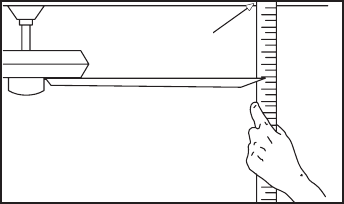
Figura 13
Cómo equilibrar las aspas
Todas las aspas se agrupan por peso. Puesto
que las maderas naturales varían en densidad,
el ventilador puede oscilar aunque las aspas
tengan el mismo peso.
El siguiente procedimiento corregirá en gran
medida la oscilación del ventilador. Verica
después de cada paso.
1. Verica que todos los tornillos de las aspas
estén asegurados.
2. La mayoría de los problemas de oscilación
del ventilador se deben a que las aspas no
están al mismo nivel. Verica este nivel
seleccionando un punto en el techo sobre la
punta de una de las aspas. Mide desde un
punto en el centro de cada aspa al punto en
techo. Mide esta distancia como muestra
la Figura 13. Gira el ventilador hasta que
la siguiente aspa quede en posición para
medir. Repite el procedimiento para cada
aspa. Las desviaciones de la medición no
deben pasar de 1/8” (3.2 mm). Enciende el
ventilador por 10 minutos.
3. Asegúrate de que la cubierta esté bien
jada al soporte de montaje en el techo y
de que este último esté bien jado a la caja
eléctrica.
Touching
Ceiling
8.
4. Intercambiar dos aspas adyacentes puede
redistribuir el peso y posiblemente mejorar
el funcionamiento.
5. Usa el kit de compensación de aspas
adjunto si sigues notando oscilación.
Tocando
el techo

Cómo instalar la carcasa
del kit de luces /conjunto
del soporte del kit de
luces / pantalla resistente
a roturas
PRECAUCIÓN - Para reducir el riesgo de
descarga eléctrica, desconecta el circuito
eléctrico de alimentación al ventilador antes de
instalar el kit de luces.
1. Aoja, pero no quites, dos de los tres
tornillos de montaje del conjunto motor-
ventilador; retira un tornillo de montaje.
(Figura 14)
2. Empuja la carcasa del kit de luces hasta el
conjunto motor-ventilador de manera que
las cabezas de los dos tornillos aojados
encajen en las ranuras tipo ojo de cerradura.
Gira la carcasa del kit de luces hacia la
derecha y aprieta los tornillos. Vuelve a
instalar el tornillo que retiraste en el paso 1
y apriétalo rmemente. (Figura 14)
3. Quita un tornillo de la carcasa del kit de
luces y aoja, pero no quites, los otros dos.
Conecta los cables del conjunto del soporte
del kit de luces a los cables del conjunto
motor-ventilador uniendo los enchufes
moldeados del adaptador. Coloca con
cuidado todos los cables y empalmes dentro
de la caja del interruptor. (Figura 15)
4. Empuja el conjunto del soporte del kit de
luces hacia arriba de manera que las cabezas
de los dos tornillos aojados encajen en
las ranuras tipo ojo de cerradura. Gira el
conjunto del soporte kit de luces hacia la
derecha y aprieta los tornillos. Vuelve a
instalar el tornillo que retiraste en el paso 3
y apriétalo rmemente. (Figura 15)
5. Coloca la pantalla resistente a roturas
dentro de la carcasa kit de luces alineando
las tres áreas planas en la parte superior de
Light Kit
Pan
Mounting
Screw (3)
Black
White
Mounting
Screw (3)
Light Kit Fitter
Assembly
Blue
White
Molded
Adaptor Plugs
Figura 14
Figura 15
VERIFICA PERIÓDICAMENTE SI LA PANTALLA
RESISTENTE A ROTURAS ESTÁ BIEN ASENTADA
HACIA LA DERECHA EN EL ENSAMBLAJE DE LA
CARCASA DEL KIT DE LUCES.
9.
Figura 16
Raised
Dimples
Flat Area
Shatter-
Resistant
Shade
la pantalla resistente a roturas con las tres
muescas salientes en la carcasa. Gira la
pantalla resistente a roturas hacia la derecha
hasta que se detenga. (Figura 16)
NOTA
Carcasa
del kit
de luces
Conjunto del
soporte del
kit de luces
Pantalla
resistente a
roturas
Supercie
plana
Tornillos de
montaje (3)
Enchufes moldeados
del adaptador
Blanco
Blanco
Azul
Negro
Tornillos de
montaje (3)
Muescas
salientes
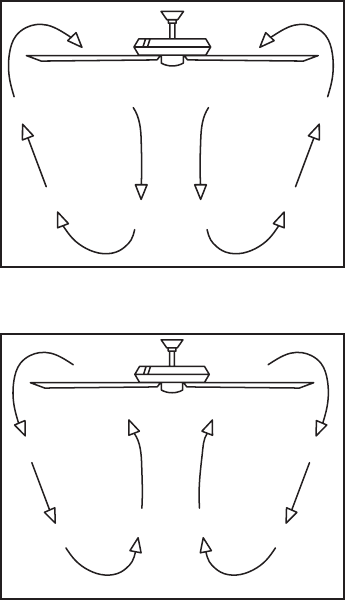
10. Cómo usar el ventilador
Las conguraciones de velocidad para clima
cálido o frío dependen de factores como el
tamaño de la habitación, la altura del techo, la
cantidad de ventiladores y otras.
Este ventilador se envía desde la fábrica con
el interruptor de reversa en posición de hacer
circular el aire hacia abajo. Si deseas encauzar
el ujo de aire en sentido contrario, apaga el
ventilador y espera a que las aspas se detengan;
enseguida desliza el interruptor de reversa
(ubicado en la caja de interruptores, consulta
la Figura 7 de la página 4) hacia la dirección
opuesta y a continuación vuelve a encender el
ventilador. Las aspas del ventilador girarán en
sentido contrario e invertirán la corriente de
aire.
Figura 17
Figura 18
Clima cálido - (Hacia adelante) Un ujo de
aire hacia abajo surte efecto refrescante, como
se muestra en la Figura 17. Esto permite jar
tu aire acondicionado en conguración más alta
sin afectar tu comodidad.
Clima frío - (Reversa) Un ujo de aire hacia
arriba desplaza el aire cálido lejos del techo,
como se muestra en la Figura 18. Esto permite
jar tu unidad de calefacción en conguración
más baja sin afectar tu comodidad.

11. Cuidado del ventilador y solución de problemas
Cuidado del ventilador
Aquí tienes algunas sugerencias para dar
mantenimiento a tu ventilador.
1. Por causa del movimiento natural del
ventilador, algunas conexiones pueden
aojarse. Revisa las conexiones de soporte,
los soportes y los accesorios de aspas dos
veces al año. Comprueba que estén seguros.
(No es necesario desmontar el ventilador
del techo).
2. Limpia el ventilador con frecuencia
para que luzca como nuevo al paso de
los años. No uses agua al limpiar; esto
puede dañar el motor o la madera e
incluso provocar descargas eléctricas.
Usa sólo un cepillo suave o un paño sin
pelusas para evitar arañar el acabado. El
revestimiento está sellado con laca para
minimizar la decoloración u opacidad.
Advertencia - Asegura que la electricidad
esté cortada antes de limpiar tu ventilador.
3. Puedes aplicar a la madera una na capa
de pulimento para muebles y asegurar
así mayor protección y superior belleza.
Cubre los arañazos pequeños con una leve
aplicación de lustrador para calzado.
4. Tu ventilador no necesita lubricación.
El motor tiene cojinetes de bola sellados y
permanentemente lubricados.
ASEGÚRATE DE QUE NO HAYA CORRIENTE EN EL PANEL DE ELÉCTRICO ANTES DE
INTENTAR HACER REPARACIONES. CONSULTA LA SECCIÓN “CÓMO HACER CONEXIONES
ELÉCTRICAS”.
El ventilador
no enciende
El ventilador
hace ruido
1. Verica los fusibles o disyuntores principales y secundarios.
2. Verica las conexiones de cables en línea al ventilador y de cables del interruptor
en la caja de interruptores. PRECAUCIÓN: Asegúrate de que la fuente
principal de electricidad esté apagada.
3. Verica las baterías en el transmisor. ¿Se enciende la luz LED roja? ¿Estás lo
sucientemente cerca del ventilador? (El rango normal es de 10-20 pies = 3 a 6
metros.) ¿Coinciden las conguraciones del interruptor en el transmisor (unidad
de mano) y en el receptor? RECUERDA CORTAR LA ELECTRICIDAD ANTES
DE VERIFICAR LAS CONFIGURACIONES DEL INTERRUPTOR EN EL
RECEPTOR.
1. Asegúrate de que los tornillos de la carcasa del motor estén bien ajustados.
2. Asegúrate de que los tornillos que unen el soporte de aspa al cuerpo del motor
estén bien ajustados.
3. Asegúrate de que las conexiones de tuerca de cable no choquen unas con otras ni
con la pared interior de la caja del interruptor.
PRECAUCIÓN: Asegúrate de que la electricidad está cortada.
4. Deja que transcurra un período de “adaptación” de 24 horas. La mayoría de los
ruidos asociados a un ventilador nuevo desaparecen en ese período.
5. Si usas el kit de luces de ventilador de techo, asegúrate de que los tornillos que
sujetan el vidrio estén bien apretados. Verica así mismo que la bombilla esté bien
jada.
6. Asegúrate de que la cubierta esté a corta distancia del techo. No debe tocar el techo.
7. Asegúrate de que tu caja eléctrica esté bien segura y de que se hayan instalado
almohadillas aislantes de hule entre el soporte de montaje y la caja de distribución.
Solución de problemas
Problema Solución
ADVERTENCIA

12. Especicaciones
TAMAÑO DEL
VENTILADOR VELOCIDAD VOLTIOS
(V)
CONSUMO
ELÉCTRICO DEL
VENTILADOR
(SIN LUCES)
WATTS (W)
FLUJO
DE AIRE
PIES3 POR
MINUTO
EFICIENCIA
DE FLUJO DE AIRE
(MÁS ALTO
ES MEJOR) PIES3
POR MINUTO/W
PESO
NETO
PESO
BRUTO
PIES
CÚBICOS
60"
(1.52 m)
Baja
120
12 1678 140 28.88
Lbs
31.97
Lbs 2.0
Media 29 2927 101
Alta 86 5388 63
©2017 Progress Lighting, Inc.
701 Millennium Blvd.,
Greenville, SC 29607
Todos los derechos reservados
Este equipo fue sometido a prueba y se determinó que cumple con los límites establecidos para un dispositivo digital Clase B según la Parte 15 de las
Normas FCC. Estos límites fueron establecidos para dar protección razonable contra la interferencia dañina en uso residencial. Este equipo genera,
consume y puede irradiar energía de radiofrecuencia; si no se instala y usa de acuerdo con las instrucciones, puede causar interferencia dañina a
comunicaciones radiales. Sin embargo, no hay garantía de que no ocurrirá interferencia en una instalación particular. Si este equipo causa interferencia
perjudicial a la recepción de radio o televisión, que puede determinarse encendiendo y apagando el equipo, se recomienda al usuario tratar de corregir
la interferencia con una o más de las siguientes medidas:
– Reorientar o reubicar la antena receptora.
– Incrementar la distancia entre los equipos y el receptor.
– Conectar el equipo a un tomacorriente en circuito distinto al que el receptor está conectado.
– Consultar al concesionario o algún técnico de radio/TV con experiencia para ayuda.
PRECAUCIÓN:
Los cambios o modicaciones sin aprobación expresa del responsable de este dispositivo podrían anular el derecho del usuario a operar el equipo.
Este dispositivo cumple con la Parte 15 de las Normas FCC. Su operación está sujeta a las dos condiciones siguientes: (1) Este dispositivo no debe
causar interferencia dañina y (2) tiene que aceptar cualquier interferencia recibida, incluyendo aquella que pudiera afectar su funcionamiento.